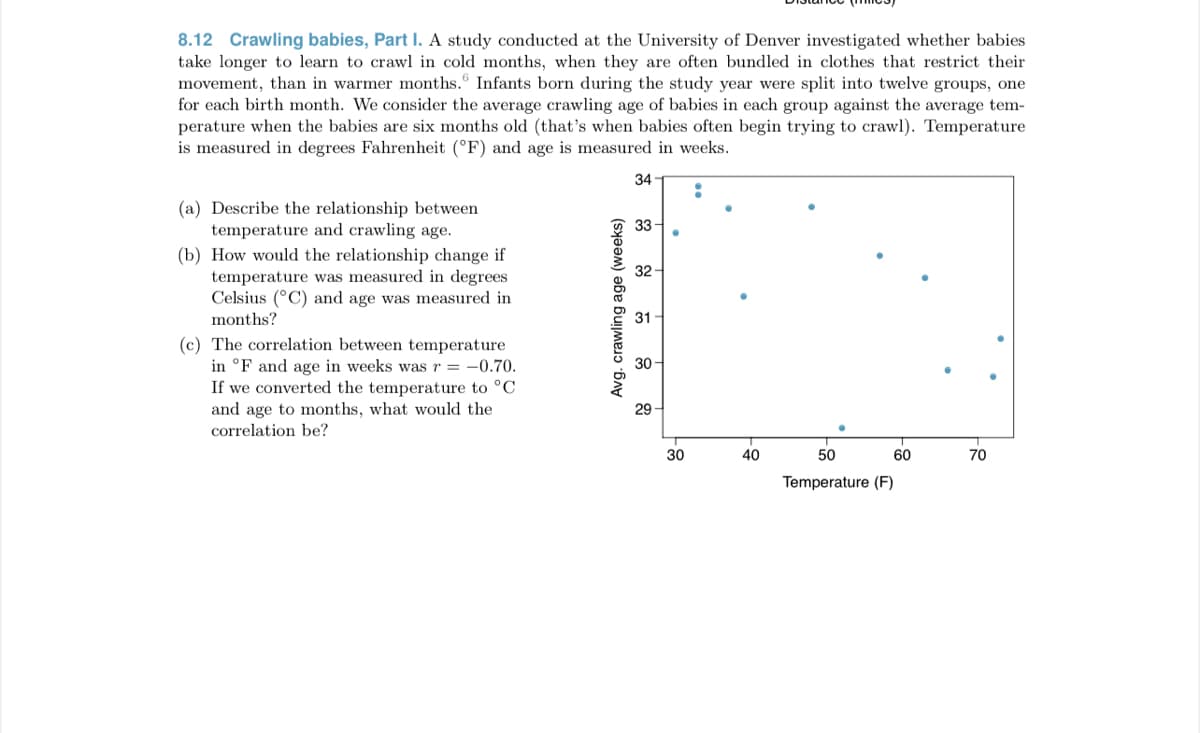8.12 Crawling babies, Part I. A study conducted at the University of Denver investigated whether babies take longer to learn to crawl in cold months, when they are often bundled in clothes that restrict their movement, than in warmer months." Infants born during the study year were split into twelve groups, one for each birth month. We consider the average crawling age of babies in each group against the average tem- perature when the babies are six months old (that's when babies often begin trying to crawl). Temperature is measured in degrees Fahrenheit (°F) and age is measured in weeks. 34 (a) Describe the relationship between temperature and crawling age. (b) How would the relationship change if temperature was measured in degrees Celsius (°C) and age was measured in 33 32 months? 31 (c) The correlation between temperature in °F and age in weeks was r = -0.70. If we converted the temperature to °C and age to months, what would the correlation be? 30 29 30 40 50 70 Temperature (F) Avg. crawling age (weeks)
8.12 Crawling babies, Part I. A study conducted at the University of Denver investigated whether babies take longer to learn to crawl in cold months, when they are often bundled in clothes that restrict their movement, than in warmer months." Infants born during the study year were split into twelve groups, one for each birth month. We consider the average crawling age of babies in each group against the average tem- perature when the babies are six months old (that's when babies often begin trying to crawl). Temperature is measured in degrees Fahrenheit (°F) and age is measured in weeks. 34 (a) Describe the relationship between temperature and crawling age. (b) How would the relationship change if temperature was measured in degrees Celsius (°C) and age was measured in 33 32 months? 31 (c) The correlation between temperature in °F and age in weeks was r = -0.70. If we converted the temperature to °C and age to months, what would the correlation be? 30 29 30 40 50 70 Temperature (F) Avg. crawling age (weeks)
Holt Mcdougal Larson Pre-algebra: Student Edition 2012
1st Edition
ISBN:9780547587776
Author:HOLT MCDOUGAL
Publisher:HOLT MCDOUGAL
Chapter11: Data Analysis And Probability
Section: Chapter Questions
Problem 8CR
Related questions
Question

Transcribed Image Text:8.12 Crawling babies, Part I. A study conducted at the University of Denver investigated whether babies
take longer to learn to crawl in cold months, when they are often bundled in clothes that restrict their
movement, than in warmer months." Infants born during the study year were split into twelve groups, one
for each birth month. We consider the average crawling age of babies in each group against the average tem-
perature when the babies are six months old (that's when babies often begin trying to crawl). Temperature
is measured in degrees Fahrenheit (°F) and age is measured in weeks.
34 -
(a) Describe the relationship between
temperature and crawling age.
(b) How would the relationship change if
temperature was measured in degrees
Celsius (°C) and age was measured in
33-
32-
months?
31
(c) The correlation between temperature
in °F and age in weeks wasr = -0.70.
If we converted the temperature to °C
and age to months, what would the
30-
29 -
correlation be?
30
40
50
60
70
Temperature (F)
Avg. crawling age (weeks)
Expert Solution
This question has been solved!
Explore an expertly crafted, step-by-step solution for a thorough understanding of key concepts.
This is a popular solution!
Trending now
This is a popular solution!
Step by step
Solved in 5 steps

Recommended textbooks for you

Holt Mcdougal Larson Pre-algebra: Student Edition…
Algebra
ISBN:
9780547587776
Author:
HOLT MCDOUGAL
Publisher:
HOLT MCDOUGAL

Holt Mcdougal Larson Pre-algebra: Student Edition…
Algebra
ISBN:
9780547587776
Author:
HOLT MCDOUGAL
Publisher:
HOLT MCDOUGAL